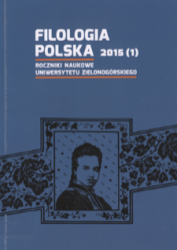Twelve steps or a miracle play about Saint Stanislaus
Keywords
Abstract
Jan Dlugosz in his almanacs speaks extensively about the miraculous coming back to life of Peter of Piotrawin [Piotr z Piotrawina]. This exceptional event was supposed to happen due to St. Stanislavus [święty Stanisław]. However, one specific term used by the chronicler makes one ponder and raise speculation, that the author, writing about the unusual episode in the life of the canonized bishop of Cracow, had recalled a miracle play he had experienced. That miracle play was probably the reconstruction of the resurrection of the aforementioned knight. It might have been prepared for variety’s sake during the celebrations commemorating the day the XIIIc. clergyman was acknowledged a Saint. The play might even have been presented at the Wawel Castle, which architecture allowed for such a staging at that time. The miracle play was lost in the track of time, although the following sketch is a hypothetical trial of its partial reconstruction.
References
LITERATURA CYTOWANA
Źródła
Annales seu Cronicae incliti Regni Poloniae…Joannis Dlugossii, red. J. Dąbrowski i in, t. II, ks. III i IV, Warszawa 1971.
[Google Scholar]
Bering P., Teatr w kronice. Studia nad dramatycznością kronik średniowiecznych, Poznań 2013.
[Google Scholar]
Opracowania
Berthold M., Historia teatru, przeł. D. Żmij-Zielińska, Warszawa 1980.
[Google Scholar]
Cichoński J. P., Dialog na uroczystość świętej Katarzyny, [w:] J. Lewański (wyd), Dramaty staropolskie, t. VI, Warszawa 1963.
[Google Scholar]
Długosz J., Roczniki, czyli Kroniki sławnego Królestwa Polskiego, red. J. Dąbrowski, S. Gawęda i in. (przeł.). Księgi III-IV, Warszawa 1961-1985.
[Google Scholar]
Drzewicka A., Skupienie i zabawa. Twórczość dramatyczna w średniowiecznej Francji do końca XIII w., Kraków 1998.
[Google Scholar]
Faral E., Życie codzienne we Francji w czasach Ludwika Świętego, Warszawa 1969. Feicht H., Studia nad muzyką polskiego średniowiecza, Kraków 1975.
[Google Scholar]
Jelicz A., Życie codzienne w średniowiecznym Krakowie (Wiek XIII-XV), Warszawa 1966.
[Google Scholar]
Juszyński H., Dykcyonarz poetów polskich, t. II, Kraków 1820.
[Google Scholar]
Katalog zabytków sztuki w Polsce, t. IV. Miasto Kraków, z. I. Wawel, red. J. Szablowski. Warszawa 1965.
[Google Scholar]
Katalog zabytków sztuki w Polsce, t. IV. Miasto Kraków, z. I: Wawel, red. J. Szablowski. Warszawa 1965.
[Google Scholar]
Konigson E., Miasto w przestrzeni teatralnej, [w:] Zwierciadło świata. Średniowieczny teatr francuski, A. Loba (red.), P.Tomczask (tłum.), Gdańsk 2006.
[Google Scholar]
Nicoll A., Dzieje dramatu, t. I, przeł. H. Krzeczkowski, W. Niepokólczycki, J. Nowacki, Warszawa 1975.
[Google Scholar]
Szymonik K., Oficjum rymowane o św. Stanisławie. Dies adest celebris i hymn Gaude Mater Polonia w polskich antyfonarzach przedtrydenckich. Studium muzykologiczne. Niepokalanów 1966.
[Google Scholar]
Targosz K., Gesta principium recitata. „Teatr czynów polskich władców” Galla Anonima, (w:) „Pamiętnik Teatralny”, R. XXIX, 1980.
[Google Scholar]
Targosz K., Korzenie i kształty teatru do 1500 roku w perspektywie Krakowa, Kraków 1995.
[Google Scholar]
Vita Sancti Stanislai episcopi cracoviensis (Vita minor et maior, W. Kętrzyński [w:] Monumenta Poloniae Historica, t. IV, Warszawa 1961.
[Google Scholar]
Voragine J., de, Złota legenda, przeł. J. Pleziowa, Wrocław 1996.
[Google Scholar]
Preview
Downloads
Published
How to Cite
Issue
Section
Categories
Copyright & License

This work is licensed under a Creative Commons Attribution-NonCommercial-NoDerivatives 4.0 International License.
Copyrights (a). In principle, authors who are not employed by the University of Zielona Góra retain the copyright, including publishing rights to the articles, without restrictions.
Copyrights (b). In principle, authors who are employed by the University of Zielona Góra, do not retain the copyright, including publishing rights to the articles. In such cases the copyright holder is the University of Zielona Góra.
Print ISSN
2450-3584-
Abstract855










































